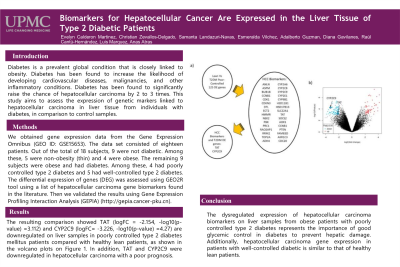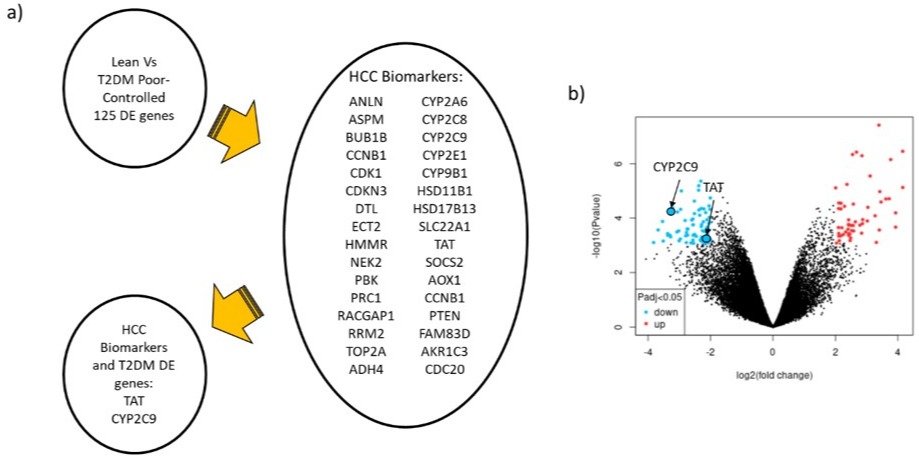Sunday Poster Session
Category: Liver
P1134 - Biomarkers for Hepatocellular Cancer Are Expressed in the Liver Tissue of Type 2 Diabetic Patients
Sunday, October 27, 2024
3:30 PM - 7:00 PM ET
Location: Exhibit Hall E

Has Audio

Evelyn Calderon Martinez, MD
UPMC Central PA
Harrisburg, PA
Presenting Author(s)
Evelyn Calderon Martinez, MD1, Christian Zevallos-Delgado, MS2, Samanta Landazuri-Navas, MD3, Esmeralda Vilchez, MD4, Adalberto Guzman, MD5, Diana Gavilanes, MD1, Raúl Cantú-Hernández, MD6, Luis Marquez, MS7, Anas Atras, MD1
1UPMC Central PA, Harrisburg, PA; 2University of Houston, Houston, TX; 3One Health Research Group, University of the Americas, Quito, Pichincha, Ecuador; 4Baylor College of Medicine, Houston, TX; 5University of Arkansas for Medical Sciences, Harrisburg, PA; 6Instituto Tecnológico y de Estudios Superiores de Monterrey, Houston, TX; 7INIA, Arequipa, Arequipa, Peru
Introduction: Diabetes is a prevalent global condition that is closely linked to obesity. Diabetes has been found to increase the likelihood of developing cardiovascular diseases, malignancies, and other inflammatory conditions. Diabetes has been found to significantly raise the chance of hepatocellular carcinoma by 2 to 3 times. This study aims to assess the expression of genetic markers linked to hepatocellular carcinoma in liver tissue from individuals with diabetes, in comparison to control samples.
Methods: We obtained gene expression data from the Gene Expression Omnibus (GEO ID: GSE15653). The data set consisted of eighteen patients. Out of the total of 18 subjects, 9 were not diabetic. Among these, 5 were non-obesity (thin) and 4 were obese. The remaining 9 subjects were obese and had diabetes. Among these, 4 had poorly controlled type 2 diabetes and 5 had well-controlled type 2 diabetes. The differential expression of genes (DEG) was assessed using GEO2R tool using a list of hepatocellular carcinoma gene biomarkers found in the literature. Then we validated the results using Gene Expression Profiling Interaction Analysis (GEPIA) (https://gepia.cancer-pku.cn).
Results: The resulting comparison showed TAT (logFC = -2.154, -log10(p-value) =3.112) and CYP2C9 (logFC= -3.226, -log10(p-value) =4.27) are downregulated on liver samples in poorly controlled type 2 diabetes mellitus patients compared with healthy lean patients, as shown in the volcano plots on Figure 1. In addition, TAT and CYP2C9 were downregulated in hepatocellular carcinoma with a poor prognosis.
Discussion: The dysregulated expression of hepatocellular carcinoma biomarkers on liver samples from obese patients with poorly controlled type 2 diabetes represents the importance of good glycemic control in diabetes to prevent hepatic damage. Additionally, hepatocellular carcinoma gene expression in patients with well-controlled diabetic is similar to that of healthy lean patients.

Disclosures:
Evelyn Calderon Martinez, MD1, Christian Zevallos-Delgado, MS2, Samanta Landazuri-Navas, MD3, Esmeralda Vilchez, MD4, Adalberto Guzman, MD5, Diana Gavilanes, MD1, Raúl Cantú-Hernández, MD6, Luis Marquez, MS7, Anas Atras, MD1. P1134 - Biomarkers for Hepatocellular Cancer Are Expressed in the Liver Tissue of Type 2 Diabetic Patients, ACG 2024 Annual Scientific Meeting Abstracts. Philadelphia, PA: American College of Gastroenterology.
1UPMC Central PA, Harrisburg, PA; 2University of Houston, Houston, TX; 3One Health Research Group, University of the Americas, Quito, Pichincha, Ecuador; 4Baylor College of Medicine, Houston, TX; 5University of Arkansas for Medical Sciences, Harrisburg, PA; 6Instituto Tecnológico y de Estudios Superiores de Monterrey, Houston, TX; 7INIA, Arequipa, Arequipa, Peru
Introduction: Diabetes is a prevalent global condition that is closely linked to obesity. Diabetes has been found to increase the likelihood of developing cardiovascular diseases, malignancies, and other inflammatory conditions. Diabetes has been found to significantly raise the chance of hepatocellular carcinoma by 2 to 3 times. This study aims to assess the expression of genetic markers linked to hepatocellular carcinoma in liver tissue from individuals with diabetes, in comparison to control samples.
Methods: We obtained gene expression data from the Gene Expression Omnibus (GEO ID: GSE15653). The data set consisted of eighteen patients. Out of the total of 18 subjects, 9 were not diabetic. Among these, 5 were non-obesity (thin) and 4 were obese. The remaining 9 subjects were obese and had diabetes. Among these, 4 had poorly controlled type 2 diabetes and 5 had well-controlled type 2 diabetes. The differential expression of genes (DEG) was assessed using GEO2R tool using a list of hepatocellular carcinoma gene biomarkers found in the literature. Then we validated the results using Gene Expression Profiling Interaction Analysis (GEPIA) (https://gepia.cancer-pku.cn).
Results: The resulting comparison showed TAT (logFC = -2.154, -log10(p-value) =3.112) and CYP2C9 (logFC= -3.226, -log10(p-value) =4.27) are downregulated on liver samples in poorly controlled type 2 diabetes mellitus patients compared with healthy lean patients, as shown in the volcano plots on Figure 1. In addition, TAT and CYP2C9 were downregulated in hepatocellular carcinoma with a poor prognosis.
Discussion: The dysregulated expression of hepatocellular carcinoma biomarkers on liver samples from obese patients with poorly controlled type 2 diabetes represents the importance of good glycemic control in diabetes to prevent hepatic damage. Additionally, hepatocellular carcinoma gene expression in patients with well-controlled diabetic is similar to that of healthy lean patients.

Figure: Figure 1. Type 2 diabetes mellitus differentially expressed genes on HCC biomarkers. (a) Diagram of the comparison between HCC Biomarkers and Type 2 diabetes mellitus. (b) Gene expression volcano plot showing upregulated (red) and downregulated (blue) genes.
Disclosures:
Evelyn Calderon Martinez indicated no relevant financial relationships.
Christian Zevallos-Delgado indicated no relevant financial relationships.
Samanta Landazuri-Navas indicated no relevant financial relationships.
Esmeralda Vilchez indicated no relevant financial relationships.
Adalberto Guzman indicated no relevant financial relationships.
Diana Gavilanes indicated no relevant financial relationships.
Raúl Cantú-Hernández indicated no relevant financial relationships.
Luis Marquez indicated no relevant financial relationships.
Anas Atras indicated no relevant financial relationships.
Evelyn Calderon Martinez, MD1, Christian Zevallos-Delgado, MS2, Samanta Landazuri-Navas, MD3, Esmeralda Vilchez, MD4, Adalberto Guzman, MD5, Diana Gavilanes, MD1, Raúl Cantú-Hernández, MD6, Luis Marquez, MS7, Anas Atras, MD1. P1134 - Biomarkers for Hepatocellular Cancer Are Expressed in the Liver Tissue of Type 2 Diabetic Patients, ACG 2024 Annual Scientific Meeting Abstracts. Philadelphia, PA: American College of Gastroenterology.
